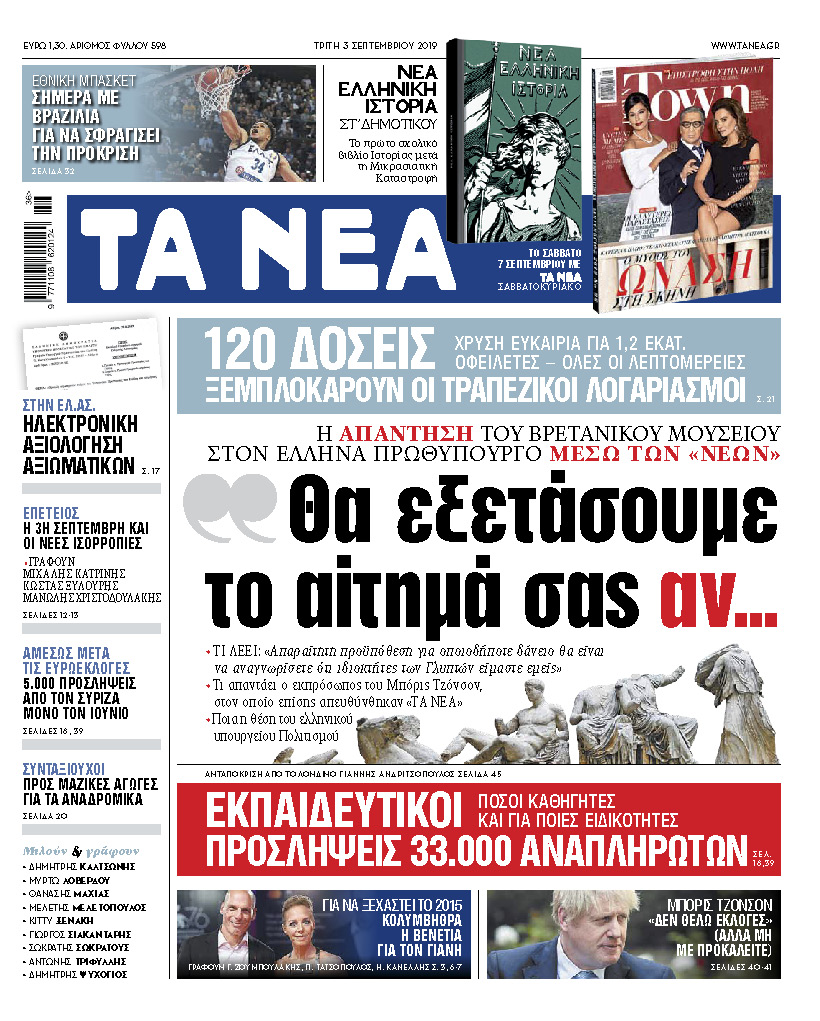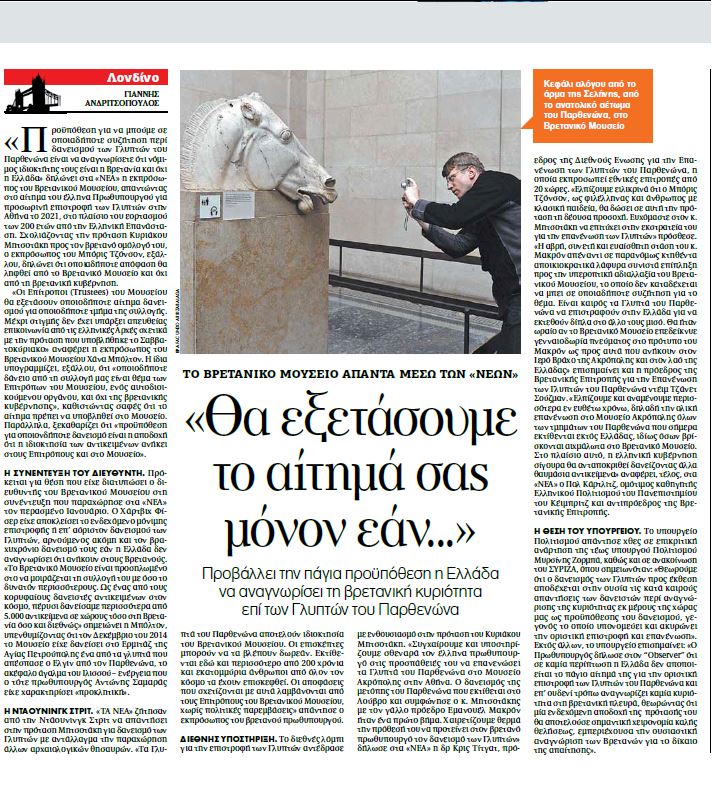03 September 2019 Yannis Andritsopoulos, London Correspondent for Ta Nea, Greece's daily newspaper wrote his report following Prime Minister Mitsotaki's offer of a loan to the British Museum made in an article published in the Guardian.
The Greek government must acknowledge the British Museum’s ownership of the Parthenon sculptures before its Trustees consider whether or not to lend the marbles to Greece, a museum representative told Ta Nea, Greece’s daily newspaper.
“A precondition for any loan would be an acceptance of ownership of those objects by the Trustees / the Museum”, a British Museum spokesperson told Ta Nea, commenting on Greek Prime Minister Kyriakos Mitsotakis’s recent statement that he will ask Prime Minister Boris Johnson to approve a loan of the Parthenon Marbles to Athens in a temporary swap with other ancient artefacts.
“The Trustees will consider any loan request for any part of the collection. As yet there has been no direct contact from the Greek authorities regarding the proposal made over the weekend”, a British Museum’s spokeswoman said, stressing that “as an arms-length body, this would be a matter for the Trustees not the UK Government.”
“The British Museum is committed to sharing its collection as widely as possible, as one of the leading lenders of objects in the world we lent over 5,000 objects to venues in the UK and internationally last year,” she added.
“The Parthenon Sculptures are legal property of the British Museum. They are free to view, have been on display for over two hundred years, and millions from across the world have seen them”, a Downing Street spokesperson told Ta Nea.
“Decisions relating to their care are taken by the Trustees of the British Museum - free from political interference,” the UK government’s spokesperson said.
Mitsotakis told the Observer on Sunday that he would ask the new British prime minister to lend the marbles to Greece as part of its bicentennial celebrations in 2021.
“Given the significance of 2021, I will propose to Boris: ‘As a first move, loan me the sculptures for a certain period of timeand I will send you very important artifacts that have never left Greece to be exhibited in the British Museum’,” said the Greek premier.
On 7 June 1816, British Parliament voted to purchase from Lord Elgin his collection of sculpted marbles from the Parthenon and elsewhere on the Acropolis of Athens. They were then passed to the British Museum, where they are now on display. The British Museum is an arms-length body not under the control of the UK government.
“The International Association for the Reunification of the Parthenon Sculptures (IARPS) and the twenty National Committees worldwide congratulate and firmly support Greek Prime Minister Kyriakos Mitsotakis in his efforts to reunite the Parthenon Sculptures in the Acropolis Museum in Athens for the festive bicentennial commemoration of the outbreak of the Greek War of Independence in 2021”, Dr Christiane Tytgat, President of the International Association for the Reunification of the Parthenon Sculptures (IARPS) told Ta Nea.
“The loan proposition Prime Minister Mitsotakis successfully agreed with French President Macron last week - the South metope X of the Parthenon on display in the Louvre in return for a collection of bronze artefacts from Greece - was a first step on the way to making a breakthrough in the long ongoing claim by the Hellenic Government for the reunification of the Parthenon Sculptures in Athens,” she added.
“We warmly welcome the announcement Prime Minister Mitsotakis made in an interview with The Observer stating that he is going to propose to Prime Minister Boris Johnson, [quote] “as a first move, to loan me the sculptures for a certain period of time and I will send you very important artefacts that have never left Greece to be exhibited in the British Museum.”
“We sincerely hope that Prime Minister Johnson, as a philhellene and Classically educated person, will give this proposition consideration, and we wish Prime Minister Mitsotakis every possible success in his campaign to reunite the Parthenon Sculptures in the Acropolis Museum in 2021,” Dr Tytgat said.
“The difference between Macron’s thoughtful, sensible and sensitive attitude to ill-gotten colonial gains stands as an admonishment to the BM’s present snooty inflexibility, which won’t deign to enter a discussion on the matter but maintains radio silence through diplomatic channels and tells outdated stories through public ones, but we fervently hope for better things from the dear British Museum very soon, as times they are a-Changing,” Dame Janet Suzman, Chair of the British Committee for the Reunification of the Parthenon Marbles, told Ta Nea.
“A twinge of discomfort might be starting to manifest itself since the BM has, we are told, printed up in the Duveen Galleries for the general public to digest, a pamphlet telling its ageing trope about universality. We would like them to show a further inclination to fair debate by publishing alongside their screed the now current view that it is high time the Parthenon marbles were graciously returned to be exhibited next to their other halves in the Parthenon Gallery of the superlative Acropolis Museum,” Dame Janet said.
She added that “it would be nice if the Museum manifested a more Macronesque largesse of spirit in regard to what belongs to the Sacred Rock and the people of Greece.”
“A mutually agreed exchange of loans is certainly far preferable to the BM's shameless soft diplomacy 'loan' of 'Ilissos' to President Putin some five years back. That I thought was a calculated insult to the Greek government. President Macron's statements on the unconditional return/reunification of 26 African art objects from France paved the way for the recent talks between Greece and France,” Professor Paul Cartledge, A.G. Leventis Professor of Greek Culture emeritus, University of Cambridge, Vice-Chair of the British Committee for the Reunification of the Parthenon Marbles, told Ta Nea.
“But of course we of the British Committee for the Reunification of the Parthenon Marbles (BCRPM) and the International Association for the Return of the Parthenon Sculptures (IARPS) hope for and expect much more in due course - namely, the total reunification in the Acropolis Museum of ALL pieces originally from the Parthenon that are currently held in museums outside Greece (not only in the BM)! But of course we campaign especially on behalf of the Marbles currently held (prisoner) in the BM,” Professor Cartledge said.
“For that eventual reunification the Greek Govt of the day will certainly reciprocate most handsomely with spectacular loans - such as those that are scheduled or will be scheduled to go to the Louvre no doubt will be,” he added.
Published in Ta Nea, Greece’s daily newspaper (www.tanea.gr) on 03 September 2019
English version: https://www.linkedin.com/pulse/greek-pm-told-he-must-recognise-british-museum-secure-andritsopoulos/
Original version (in Greek): https://www.tanea.gr/print/2019/09/03/lifearts/tha-eksetasoume-crto-aitima-sas-monon-ean/

